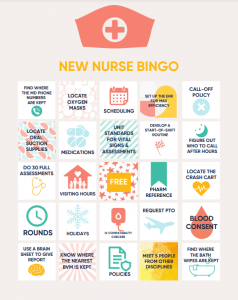What to do in Your First Five Shifts as a New Nurse
 Starting out as a new nurse can be one of the most challenging and rewarding life transformations you can make. The learning curve is enormous, the stress can feel overwhelming, and you may feel like you’re not sure what to focus on as you take on this new role. Whether you’re going through a formal residency program or just getting a “down-and-dirty” orientation, focusing on these items in your first five shifts can help you get your feet under you a little more quickly. You can also listen to this information in episode 211 of the Straight A Nursing podcast, available from this website or wherever you get your podcasts.
Starting out as a new nurse can be one of the most challenging and rewarding life transformations you can make. The learning curve is enormous, the stress can feel overwhelming, and you may feel like you’re not sure what to focus on as you take on this new role. Whether you’re going through a formal residency program or just getting a “down-and-dirty” orientation, focusing on these items in your first five shifts can help you get your feet under you a little more quickly. You can also listen to this information in episode 211 of the Straight A Nursing podcast, available from this website or wherever you get your podcasts.
I’ve broken them up into three categories – general, nursing related, and technology.
General Things
Learn where things are located. Your unit likely has multiple storage areas such as a supply room, a clean utility room, dirty utility, a medication room and equipment room. Take some time in each of these areas to learn what supplies or equipment are stored there so you always know where to go. For example, in the unit where I work, the IV fluids are in the supply room, but in other units they may be in the med room. The ICU I worked in for years kept the bathing wipes in the equipment room, though one would think they’d go in the supply room. Get to know the layout and what goes where.
Learn how to communicate with and notify the MDs. You will soon learn that knowing who to call for any particular patient problem is absolutely vital. Many times hospitals contract out services (especially specialty services), so the MD you are calling may not be an employee of the hospital. For example, my hospital utilizes two different nephrology practices to care for our renal patients. So I had to know which nephrology practice to call when my patient needed something.
Another thing to consider is knowing who to call after hours. The MD following your patient during the day is not likely to be the same one you should call at 2am. So, knowing how to figure out the call schedule so you always wake up the right physician is really important.
Additionally, some units have a specific process for calling MDs. For example, if your facility utilizes hospitalists, the practice may be for you to call the resident first. Or, some units have you funnel calls to the MD through the charge nurse.
Get the flow of the unit. Pay careful attention to how the unit flows in those first few shifts. Things to take note of are:
- Unit standards for taking vital signs and performing assessments
- What time rounds take place and who participates
- Visiting hours and visiting guidelines
- Any standard treatment pathways – for example, the CVSICU (cardiovascular surgery ICU) where I work has strict guidelines of getting all un-sedated patients up to the chair for breakfast, lunch and dinner (provided they are stable enough to do so). These patients have tubes and lines everywhere, but those nurses get those patients out of bed three times a day…and while that may not sound like much…try it once and you’ll see what a commitment that is to excellent patient care. Another example is how we managed CT scans in the trauma neuro ICU I worked in. The unit routine was to take those patients to CT scan around 6am so that the surgeons could review the results before doing rounds.
- Any quiet time that is observed – these are periods during the day and night where nurses try not to disturb the patients unless absolutely necessary. This gives the patients some much-needed uninterrupted rest, so you may need to plan your care around quiet time if your unit follows this practice.
Get to know your resources. Patient care does not fall solely on the shoulders of the RN. There is actually a whole interdisciplinary team composed of professionals who work together to help patients meet their goals. In your first few shifts, meet as many people from the interdisciplinary team as you can. Ask them what their role is and how it fits into the patient’s plan of care. This way, when your patient has a problem, you always know the right resource to use or the right person to reach out to.
Learn how to manage your schedule. Each unit has their own unique way of scheduling and meeting staffing needs. A few things to learn how to do right off the bat are:
- How to put in schedule requests if your unit follows that process
- How to request PTO – some units will have guidelines around vacation requests. For example, the ICU where I worked required everyone who wanted a full week or more off work to submit vacation requests in November. The management team would then look at all the requests and grant the time off based on staffing needs. This meant knowing far far far in advance of your vacation plans FOR THE ENTIRE YEAR (and another reason I work per-diem now!).
- Know how the unit manages holidays. Some ask you to rank the holidays in order of importance or require you to work a minimum number of holidays. While you’re at it, find out what constitutes a “holiday.” For example, is the Friday after Thanksgiving a holiday? What about Christmas Eve or night shift on July 3rd? There should be a calendar available with all the hospital holidays listed.
- Learn the unit’s call-off policy. When units are overstaffed, they will “call-off” staff. Make sure you understand how this works and if you are able to request to be called off in advance. For example, let’s say you could really use a mental health day but haven’t got a vacation planned. You may be able to put yourself on the call-off list so that if the unit finds itself overstaffed on the day you’re supposed to work, they’ll cancel your shift rather than cancel someone who really wants to work. This will be called different things at different facilities. At my hospital, it’s called HRAD (and honestly I could not tell you what the letters stand for but it’s something staffing related). Conversely, make sure you know how they determine who to call off and that canceled shifts are tracked so that it is equitable to all staff.
Nursing Related
Focus on pharmacology. Make note of the most commonly used drugs on that unit and learn them from top to bottom. As you take care of patients in those first few shifts, keep a running list of the medications you see used and devote your attention to learning the most common ones first. For example, if you’re working on an ortho unit, you’ll want to know pain medications, stool softeners, reversal agents, and antibiotics. If you’re working on a telemetry floor, then you’re going to be using a lot of cardiac-related medications such as metoprolol, digoxin, lisinopril and furosemide.
Develop a start-of-shift routine. This is absolutely essential for setting yourself up to have a good shift. Just know that start-of-shift routines are going to vary based on what type of unit you work on and how many patients you have. Don’t expect to get it correct right off the bat. Play around with it, be willing to try new things and then once you find a routine that feels right…stick with it and see how it goes.
Cue into your hypervigilance. Being a nurse means being ON for an entire shift. When you’re ON, you’re hyper-aware of everything going on around you. It is your job to be the observer of your patient and to NOTICE things. Practice staying in the moment, and taking in what you are hearing, seeing, smelling, observing. Get used to all the normal sights and sounds of the environment so that you can quickly notice when things are off. For example, in the PACU we use continuous monitoring with audible sounds that correlate with the patient’s oxygen saturation level. In that environment, you quickly get used to the tone of a “normal” SpO2. When a patient desaturates, the tone changes. So, without even looking at the monitor, you know a patient needs to breathe more deeply or get some oxygen, simply based on a slight change in tone. Over time, you’ll get to where you can walk into your patient’s room and almost instinctively know something is off…it’s because of this hypervigilance.
Practice doing assessments. Now that you’re out of school, you can get your hands, eyes and ears on a LOT more patients. Do as many physical assessments as you can on as many body types, ages, and disease conditions as you possibly can.
Get your hands on supplies and equipment. Even in the best of circumstances, clinical experiences are limited. So, now is your chance to get your hands on absolutely anything you can. If you’re not comfortable doing a skill, that’s ok. Ask your preceptor to demonstrate the first time, then GO FOR IT the next time (with supervision, of course) and then ask for feedback. Hang IV piggy bags, insert NG tubes, start IVs, set up suction in the room…basically do as much as you possibly can!
Get comfortable with receiving and giving report. One of the key ingredients to successful report is using a brain sheet (you may also hear it simply called a report sheet). Don’t be afraid to try a few different types or even make your own. The recommended format to follow is SBAR focusing on patient problems that are being addressed. For example, you don’t need to go into the patient’s appendectomy 5 years ago, but do need to mention the nausea she’s having today. Her shoulder surgery last year probably isn’t a factor, but the back surgery she had a week ago probably is. Chronic conditions like heart failure and hypothyroidism may not be the reason your patient is admitted, but these issues will still be addressed during the hospitalization, so you’ll want to include them in your report. For more information about using a brain sheet check out this podcast episode here.
Technology
Practice navigating the EHR. Yes, you will be charting assessments, interventions and medications but you also want to take some time to explore the EHR. There’s a wealth of information in there, so click around and get comfortable navigating. Some key things you want to know how to locate in the medical record are:
- Where to find EKG tracings
- Where to locate signed surgical and blood consents
- How to find the patient’s wife’s phone number
- Where to document or locate a list of the patient’s home medications
- Where total fluid volume is located
- How to determine how many blood transfusions the patient has had this admission
- Where to locate the patient’s blood type
- How to view lab results, including imaging studies
- How to find the discharge summary from the patient’s last admission (this can be really helpful to see the “big picture” for patients dealing with chronic conditions and frequent hospitalizations).
- How to locate narrative notes from the MD, nurses, and other members of the team.
- Where to find the H&P
- How to see what drugs and fluids were given in the ER or operating room
Set up your account in the EHR for max efficiency. Chances are, you’ll be able to customize the flowsheets that automatically show up under your login. Ask your preceptor how their EHR is organized, and maybe a few other people as well. This will give you an idea of the flowsheets you’ll use the most often, so you can customize your account for ease of use. For example, with EPIC, you can customize the flowsheets by “wrenching in” items and customizing the display.
Find the IV compatibility checker your hospital uses. Before funneling two or more medications and fluids through the same IV line, you must check compatibility. Make sure you know where the IV compatibility checker is located…it may be a link from the medical record or from the intranet. Bookmark this one, because you’ll use it often.
Bookmark your hospital’s pharmacology reference. This is another one you’ll be using frequently. It may also be accessible from within the MAR, so make sure you know how to do that as well. Even though you’re licensed now, you still must know the meds you are giving and there’s no shame in looking things up.
Know where and how to look up policies. Whenever a procedure comes up that you are at all unsure of, you can always refer to the hospital policy. I’ve been a nurse for quite a few years now and I still look up policies regularly, especially on procedures or equipment that are new to me (or that I haven’t utilized in some time). Make note of the policies you’ll utilize most often, and share a copy to your user profile for even quicker access.
To get this information in audio format, click here or subscribe to Straight A Nursing podcast and look for Episode 211.
I hope this was helpful as you transition from new grad to new nurse! Want a quick reference? Download “New Nurse Bingo” here and see how many you can check off in your first five shifts!
(The story originally appeared in the Straight A Nursing Student blog.)




